SideFX releases Houdini 19.5
SideFX has released Houdini 19.5, the latest version of its procedural 3D software for visual effects. game development and motion graphics.
Although SideFX describes it as a “quality of life” release, it features changes throughout Houdini’s toolset, from 3D modelling to character effects, simulation, the Solaris scene layout toolset and the Karma renderers.
Highlights include making FLIP fluids available as SOPs, a new Shallow Water solver, Pyro source instancing, an intelligent Look At system for crowds, new Solaris layout brushes, and the return of ‘Frankenmuscles’.
In addition, several previously experimental features are now production-approved, with Karma CPU now officially “ready to take over render duties” from the legacy Mantra renderer.
The new features were revealed at a live event this week, the recording of which is embedded below.
One of the biggest ‘quality of life’ releases you’ll ever see
SideFX describes Houdini 19.5 as a “quality of life” release, focusing on improving the workflow and performance of existing tools, rather than on adding new ones.
“Our self-mandate for this dev cycle was to cool our jets a bit,” said SideFX vice president of product development Cristin Barghiel.
“We’ve been going at top speed for what seems like a decade now, putting out lots of new … frameworks and architectures, so this felt like the right time to have a release where we just focus on quality of life.”
Nevertheless, by the standards of most software developers, Houdini 19.5 is still a pretty major update – and one that does actually introduce quite a few new features in its own right.
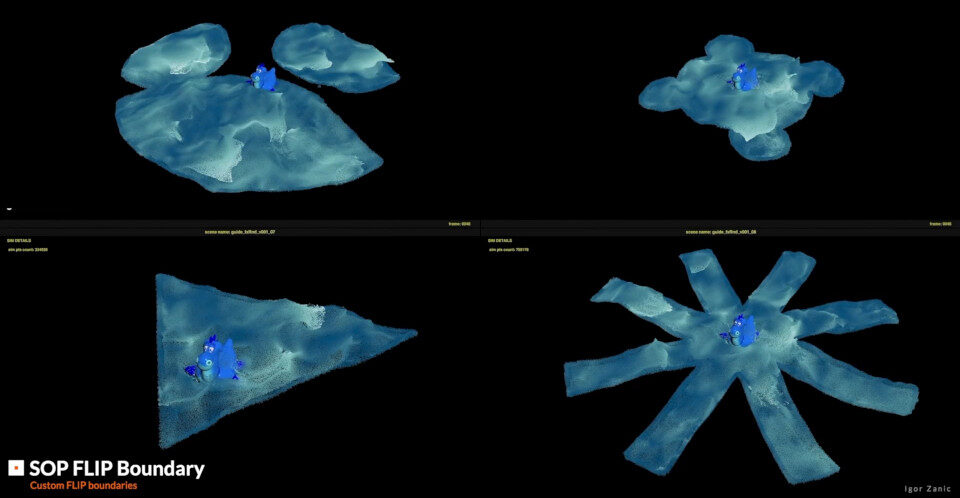
Fluid simulation: FLIP fluids now available as SOPs
Perhaps the best example of this is liquid simulation, where FLIP fluids – originally implemented as DOP (Dynamic OPerator) networks – are now available as more artist-friendly SOPs (Surface OPerators).
The change means that all* of Houdini’s dynamics solvers are now available via SOPs, with rigid bodies, Pyro smoke and fire simulation, and Vellum soft bodies and cloth having been ported in previous releases.
As well as introducing the new nodes necessary, and converting the relevant Shelf tools to SOP workflow, the release introduces new ways to control FLIP simulations.
Most notably, FLIP simulations can have custom boundaries: this video shows some pretty crazy shapes.
The change makes it possible to resize boundaries dynamically: one use case shown in the video is the simulation boundary around a boat expanding as the wake behind it grows.
SOP FLIP fluids can also solve for pressure or velocity boundary conditions, with pressure-based simulations tending to generate more turbulent, “splashy” results.
In addition, Houdini 19.5 introduces new workflows for upresing fluid simulations: for example, to generate the detail necessary for close-up shots of a larger simulation.
Users can run part of a simulation at high-resolution based on the same boundary conditions as the low-resolution sim, then combine the results based on distance from the camera.
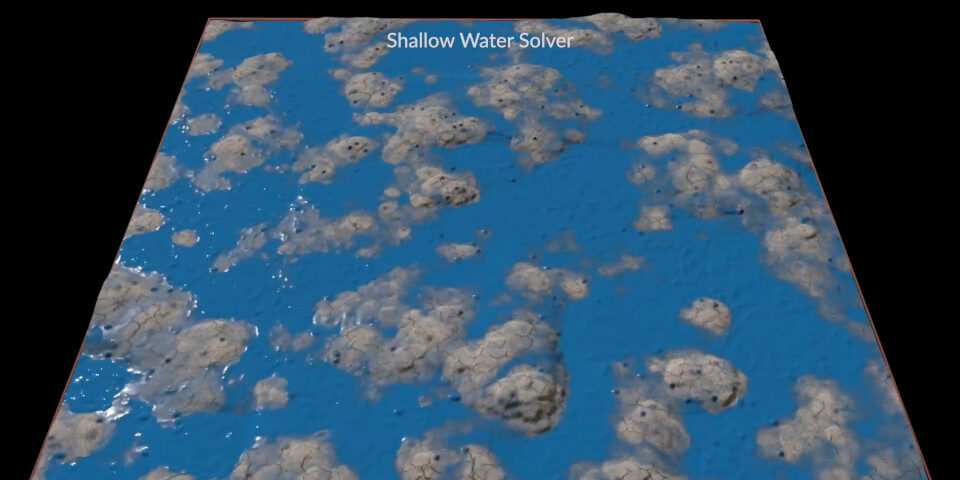
Fluid simulation: new Shallow Water solver, Encino waves and Kelvin wakes
There are also completely new fluid simulation tools in Houdini 19.5, including the Shallow Water solver.
It’s a 2D solver, based on height fields, and uses a texture-based workflow, with users able to control simulations via masks, and to export velocity and curvature maps as well as the height fields themselves.
Like the existing, particle-based Ripple solver, the Shallow Water solver can be used to generate surface ripples on sheets of water, but it does so much more quickly, solving in “a second or so” per frame.
It also interacts strongly with underlying terrain, as shown in the image above, making it a good fit for situations like thin sheets of water, or puddles forming on uneven ground.
Elsewhere in Houdini, the existing Ocean Spectrum SOP now supports Encino waves as well as Tessendorf waves, making simulation set-up easier.
And outside the main application, SideFX Labs, SideFX’s suite of experimental add-on tools, now features a tool for generating Kelvin Wakes.
It’s a deformer rather than a simulation system, making it a near-real-time solution for generating wakes behind boats and other objects travelling across an ocean surface.
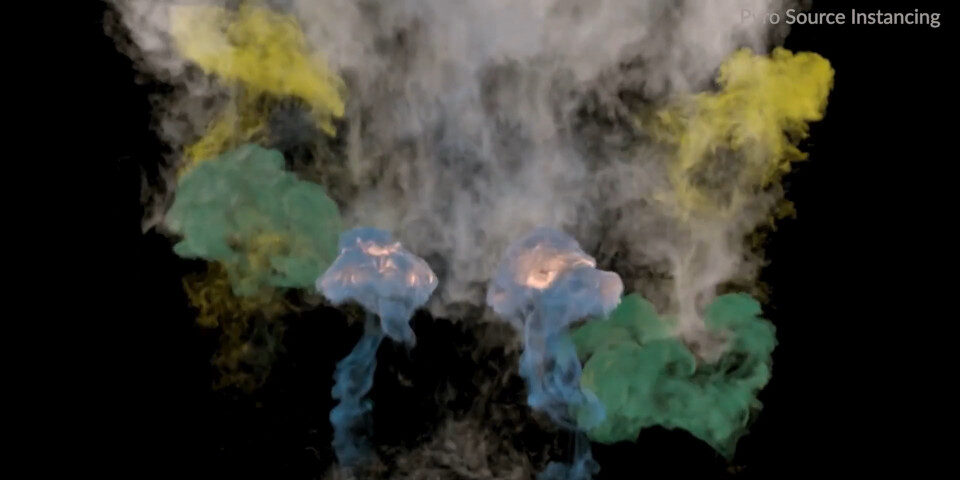
Smoke and fire simulation: source instancing and voxel scaling
Pyro, Houdini’s toolset for smoke are fire simulation, also gets several key workflow improvements.
The main one is that source instancing – previously only available for GPU simulations using the Minimal OpenCL solver – is now available as a general tool.
Unlike previous Pyro instancing workflows, the change makes it possible to apply transformations to sources, and to use multiple different Pyro sources simultaneously in a simulation.
That lets FX artists build up a library of reusable Pyro elements – bursts, trails, secondary explosions, and so on – that can be ‘composited’ together to build up more complex effects.
As with the update to FLIP fluids, it moves simulation workflow away from creating a single, monolithic sim towards creating a set of modular parts that can be distributed across a render farm.
Houdini 19.5 also introduces a new Velocity Voxel Scale parameter, making it possible to define the volume and velocity voxels for a Pyro simulation separately.
That makes it possible to reduce the resolution of the velocity, cutting simulation time, without removing detail from the underlying smoke or fire, as shown in this video.
In addition, the OpenGL viewport now has better environment lighting for volumes, making it possible to preview Pyro simulations more accurately.
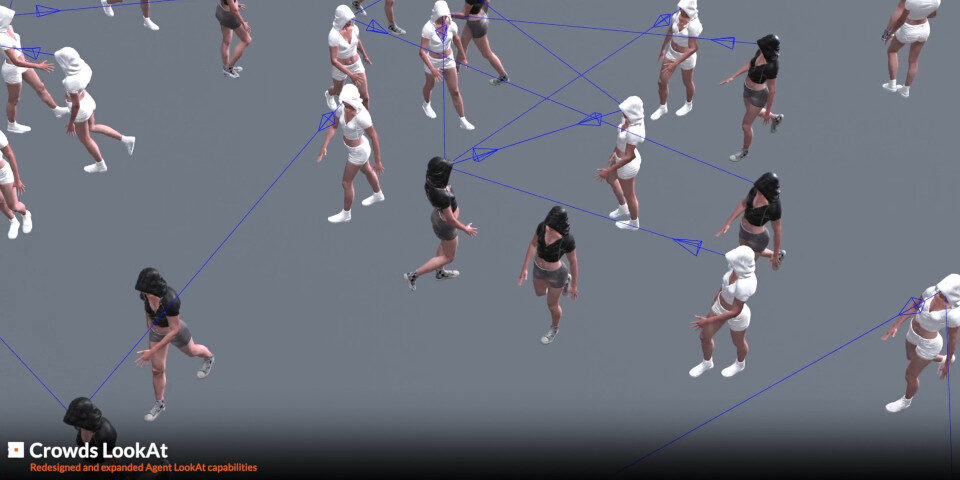
Crowd simulation: intelligent Look At targeting
Houdini’s crowd simulation tools get a reworked Look At system for crowd agents.
Unlike the previous system, which only supported a single look-at target, it supports multiple targets, including other agents in the crowd, and point clouds.
Users can control how ‘interesting’ a target is to an agent, based on its proximity, relative velocity and location in the field of view, while a Gaze Duration setting controls how long it will hold that agent’s attention.
It’s even possible to weight the agent’s eye, head and spine motion separately, as shown in this video, resulting in more naturalistic-looking behaviour.
SideFX describes the system as a way to “add character to a character … without keyframe animation”.
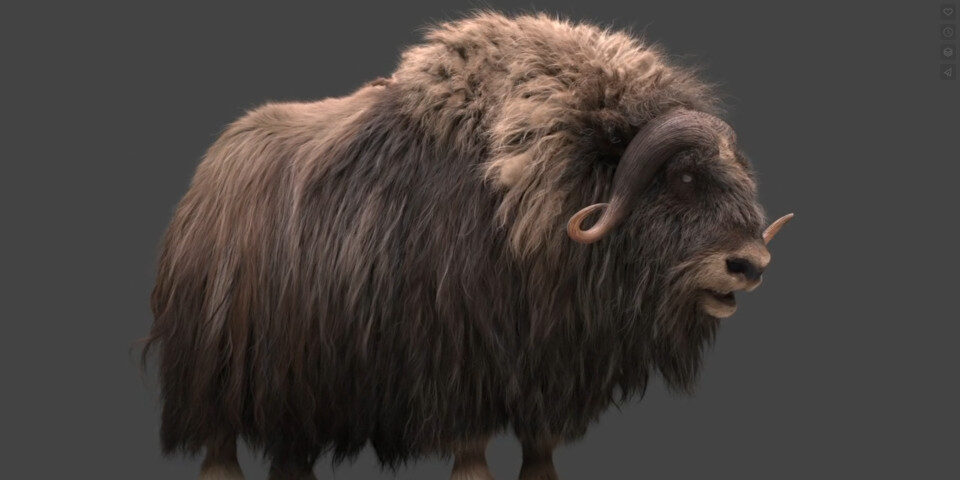
Hair and fur simulation: updates to grooming, plus new hair procedurals
SideFX describes Houdini’s hair grooming toolset as being “completed” in Houdini 19.5, making it a full production-ready toolset rather than a work-in-progress feature.
The changes are largely workflow improvements, like support for mirrored actions on asymmetric grooms, and – not shown at the launch event, but mentioned in the feature list – a new interactive hair cutting tool.
For rendering hair, the update introduces a new hair procedural and a HUSK procedural.
As with the existing fur procedural for Houdini’s Mantra render engine, they generate hair curves at render time, rather than users having to save out the curves to disk.
Both work with Karma CPU and XPU, Houdini’s new render engines; the HUSK procedural also works with any third-party renderer available as a Hydra render delegate in Houdini, including Arnold and RenderMan.
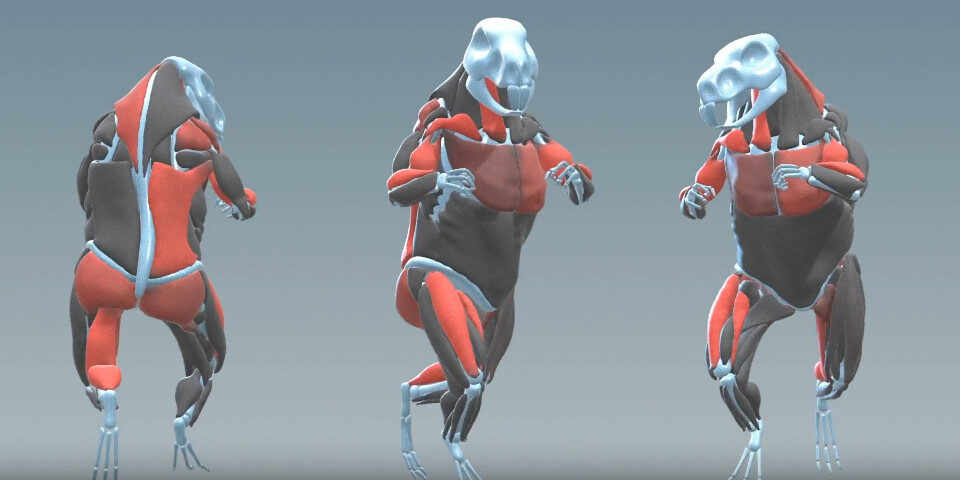
Muscle and tissue simulation: rigid spacers and ‘Frankenmuscles’
Houdini’s new muscle and tissue toolset – currently officially in beta – and Vellum, Houdini’s position-based dynamics solver, also get a number of updates.
Key changes include the option to add rigid spacers to a muscle system: collider objects that stop muscles from touching – for example, to prevent clothing from becoming trapped in a bulky character’s armpits.
In addition, the old ‘Frankenmuscle’ system introduced in Houdini 16.0 makes a comeback, but for the Vellum solver rather than the older FEM solver.
It enables artists to combine multiple muscles into a single mesh while retaining the ability to trigger them individually, making it easier to recreate large muscle groups like the deltoids.
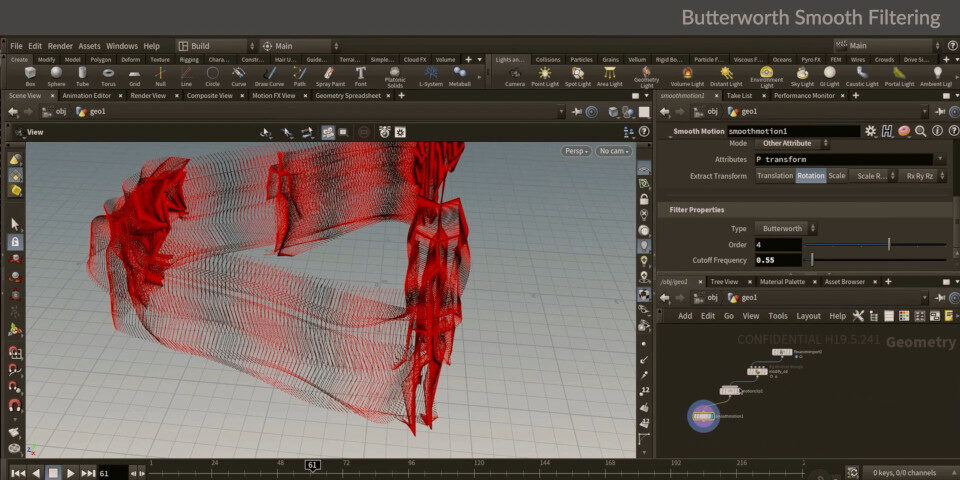
KineFX: better motion smoothing, but no major changes just yet
KineFX, the character rigging framework introduced in Houdini 18.5 gets performance and workflow improvements – although sadly, not the major update that many character artists were hoping for.
Changes include the addition of Butterworth filtering for smoothing animation data – for example, to remove jitter from mocap data – available both in the Animation Editor, and via a new Smooth Motion SOP.
The latter provides a high degree of control over smoothing: this video shows high-frequency noise being removed from some parts of a character’s body, while simultaneously smoothing the overall motion of others.
According to SideFX, the much-anticipated expansion of KineFX into a complete physics-aware character animation framework will follow in Houdini 20.
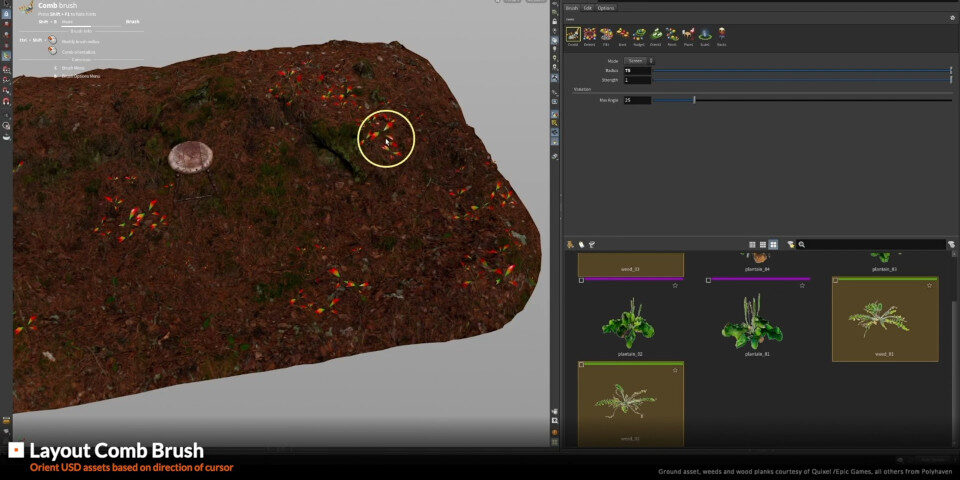
Solaris: new layout brushes and light filters
Solaris, Houdini’s USD-based toolset for scene layout and lighting, continues to evolve, with new layout brushes for populating scenes with objects.
They include a Paint brush, which places assets in a scene with random orientation, scale and rotation, and a Stack brush, which does much the same, but also arranges them into vertical stacks.
Once placed, a new Comb brush makes it possible to reorient objects by ‘combing’ them like a hair groom.
Other changes include the option to set a moveable render region, making it possible to view parts of a scene being laid out at higher quality than the standard viewport interactive preview.
Houdini 19.5 also introduces a new system of Light Filters, available when using the Karma renderers, which recreate real-world lighting set-ups like gobos and gels.
Unlike existing equivalents, they can be applied to networks of lights, not just individual lights – at least, if you’re using Karma CPU – with users able to create custom filter effects using MaterialX nodes.
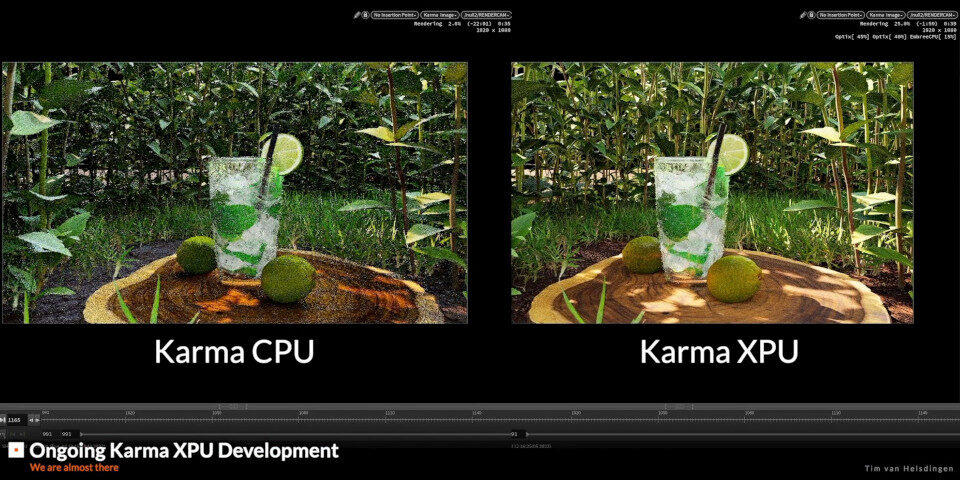
Karma: Karma CPU now an official replacement for Mantra
The new render engines introduced as part of Solaris both take a big step forward, with Karma CPU now described as “ready to take over” from the older Mantra engine as Houdini’s primary renderer.
To get to that point, SideFX has added new functionality to MaterialX, used to define Karma shading networks, including new options for procssing surface curvature and render-time edge rounding.
Neither is part of the current MaterialX open standard, which is awaiting an “official equivalent”.
In addition, Karma XPU, the new hybrid GPU/CPU version of the renderer, moves out of alpha and into beta.
New features supported on the GPU include subsurface scattering, bump mapping and cylinder lights.
You can find a full list of new features in both versions of Karma here: as well as the MaterialX changes, Karma CPU gets support for coving (watertight subdivision/displacement) and a new Cryptomatte LOP.
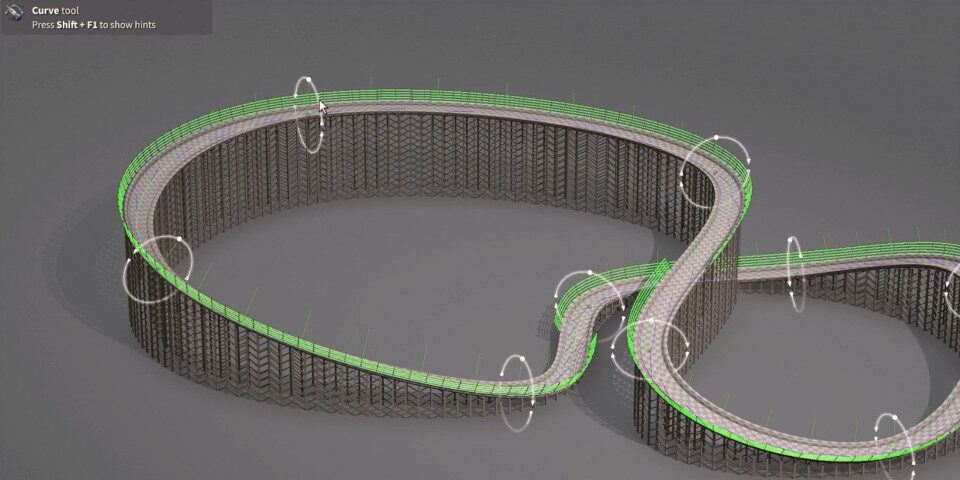
3D modelling: PolyWire UV and Poly Scalpel tools available via SideFX Labs
The core 3D modelling toolset gets updates to existing tools, with the Curve tool getting controls for orienting tangents interactively, used to adjust the banking on the race track in the image above.
However, completely new tools are available via SideFX Labs, including PolyWire UV, for creating poly wire objects like trees, and Poly Scalpel, for cutting splines with surfaces or other splines.
It has a range of potential use cases, shown in this video, from creating building floorplans to road networks.
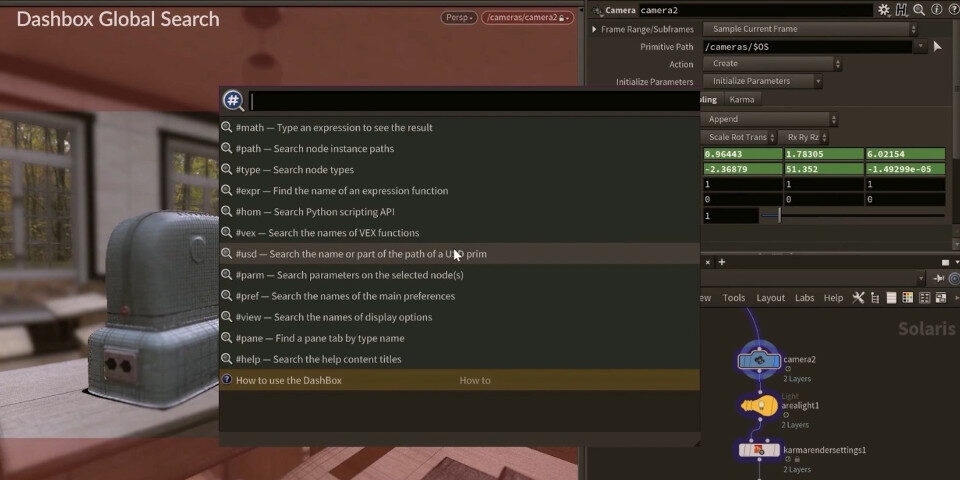
Other new features: Dashbox global search, and new scan clean-up tools
Other new features include Dashbox, a new global search interface, making it possible to search for anything from display settings to node types, expression functions, and even help documentation.
Users can jump from the Dashbox to other interface panels, making it a quick way to adjust parameter values: in future, it may even be possible to adjust settings directly inside the Dashbox itself.
Pipeline integration changes include updates to the Unity and Unreal Engine plugins, the latter of which is now compatible with the new features from Unreal Engine 5.0, inclding Nanite geometry streaming.
Houdini also becomes the latest application to deprecate Python 2, SideFX having supported version 3 of the programming language since Houdini 18.
Other new tools added to SideFX Labs include a complete toolset for cleaning up scan data.
It has a number of interesting features, like using occlusion data to remove detail selectively from less visible parts of the mesh, and a spectral transfer feature which “works like the Clone [Stamp] in Photoshop”, and which can be used to transfer fine surface detail from one part of a scan to another.
Pricing and system requirements
Houdini 19.5 is available for Windows 8+, macOS 10.15+, and Linux distros.
Houdini FX costs $4,495 for a node-locked licence; $6,995 for a floating licence. Houdini Core, which lacks advanced simulation tools, costs $1,995 for a node-locked licence; $2,995 for a floating licence.
You can find more details, including rental pricing and educational discounts, on SideFX’s website.
There is also a free Houdini Apprentice learning edition and a lower-cost, rental-only Houdini Indie edition. Both save in their own file formats and have feature restrictions. See a product comparison table here.
Read an overview of the new features in Houdini 19.5 on SideFX’s website
Read a full list of new features in Houdini 19.5 in the release notes
*Well, almost. The Whitewater Solver is still only available as a DOP. SideFX says a SOP version is due soon.
